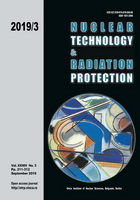
RADON CONCENTRATIONS IN HENNA (LAWSONIA INERMIS) LEAF SAMPLES COLLECTED FROM BASRAH, IRAQ

Vol.
XXXIV, No. 3, Pp. 211-312
September 2019
UDC 621.039+614.876:504.06
ISSN 1451-3994
Pages: 285-290
Authors: Rasha S. Ahmed, Raghad S. Mohammed, and Ali A. RadhiAbstract
Henna leaves are a priority material for hair dyes and body tattoos and have been used for this purpose for decades. In Iraq, henna is used widely but it requires substantial controls. Iraq is considered an environmentally polluted area as a result of the wars it has experienced, hence, this study has been conducted to calculate the level of 222Rn contamination in henna leaves using a CR-39 nuclear track detector. The leaves were collected from the province of Basrah, which is located in southern Iraq and is famous for cultivation of this plant. The radon concentrations were found to range from 12.140 to 16.255 Bqm-3 in Al-Faw, and from 7.613 to 11.111 Bqm-3 in Abu Al Khasib. Radon activity ranged from 6.09·10-4 to 8.16·10-4 Bq in Al-Faw, whereas, in Abu Al Khasib it ranged from 3.82·10-4 to 5.58·10-4 Bq. Radon specific activity ranged from 1.22·10-4 to 1.63·10-4 Bqg-1 in Al-Faw, and from 7.64·10–5 to 1.12·10-4 Bqg-1 in Abu Al Khasib. The radon exhalation rate ranged from 4.05·10-4 to 5.43·10-4 with an average of 4.69·10-4 Bqm-2d-1 in Al-Faw, and from 2.54·10-4 to 3.71·10-4 with an average of 3.22·10-4 Bqm-2d-1 in Abu Al Khasib. After obtaining the results, one can conclude that the henna plant collected from these areas is safe for human use and is free from high rates of 222Rn.
Key words: henna, Iraq, CR-39 detector, radon concentration, radioactivity
FULL PAPER IN PDF FORMAT (576 KB)